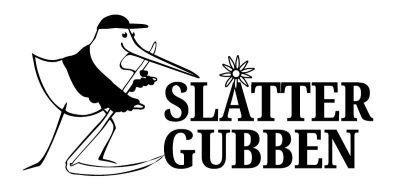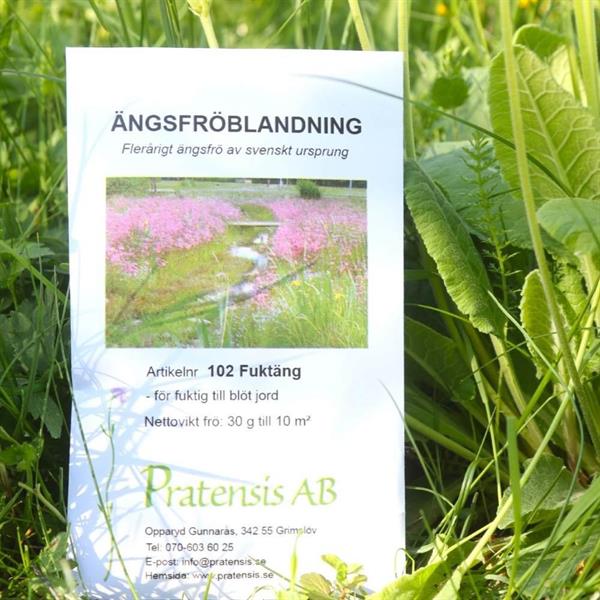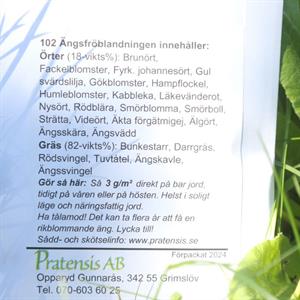Meadowseeds - wet - 30g. Pratensis
Price: 14 SEK/sqm. Seeds for 10 sqm.
- In stock
Description
Contains:
Grass 82%
tufted sedge, quaking grass, red fescue, tufted hairgrass, meadow foxtail, meadow fescue
Herbs: 60%
purple loosestrife, imperforate St. John’s Wort, yellow flag iris, ragged-robin, hemp-agrimony, water avens, marsh marigold, garden heliotrope, sneezewort, red campion, meadow buttercup, globe flower, wild angelica, yellow loosestrife, true forget-me-not, sawwort, meadowsweet, devil's-bit scabious
Producer: Pratensis AB. Pratensis is meticulous about using Swedish genetic material in their mixtures of real meadow plants. For a much larger selection of various meadow seed blends and plants, contact Pratensis directly.
Suitable for: Wetlands, ponds, and ditch edges.
Creating a meadow is probably the best ecological summer bird food option! It’s a truly beautiful insect factory! And it’s a perpetual machine—it only needs to be established once.
See our video on creating meadows here>
When you’re creating a meadow:
Wow, you’re amazing—and brave—stand tall and be proud. I know your biggest challenge is likely someone or a few people who question tall grass, find it embarrassing that you’re doing this, and think it "doesn’t look cared for," or are afraid of ticks, snakes, and the work of mowing the meadow.
It’s people like you, and all of us who are fighting for meadows, flowers, wild bees, butterflies, and birds, who are the real heroes! And we’re part of a much larger movement that’s growing rapidly!
In some cases, there’s already a good meadow on your land despite years of mowing or overgrowth! In that case, it’s unwise to sow for two reasons:
- It costs money, work, and time.
- Many of the plants that thrive there aren’t in the seed mixture, and they also have the local genetic variation. Among them, there may already be rarer species than those in a good meadow seed blend!
Tips on how to assess, or get simple help with assessing your land >
The area you sow in should be bare, open soil without perennial weeds and live grass tufts.
The best approach is to dig in the spring and then rake/turn the soil repeatedly throughout the summer as soon as any green shoots appear. If roots from plants like couch grass or bindweed are present, it’s important to bring them to the surface and let them dry out.
Sow in the autumn and let the seeds lie entirely on the surface!
Then care for it as a meadow each year with mowing and removal of the grass.
Be patient—a meadow gets better with time. It always takes at least three years for many of the meadow flowers to make an appearance. It’s completely natural that many of the plants in the blend won’t show up in your meadow. No two meadows are the same, and conditions vary everywhere!
The meadow, which was once a natural part of the agricultural landscape, is now more of a relic preserved for its biodiversity at a few select locations. You can help increase the percentage of meadow land by creating a small piece in your garden. In this way, we are recreating, in miniature, some of the landscape that has disappeared out there among farms and fields. The meadow, with its enormous biodiversity of flowers and insects, was and is an incredibly important habitat for many bird species to forage in. It is mainly the wealth of insects that attracts them.
Hay was harvested from the meadow every year, so to care for a meadow, you should mow it in late summer and remove the grass. To create a species-rich meadow, it should be depleted of nutrients. In overly nutrient-rich environments, a few species of grass and herbs take over (Cocksfoot grass, false oat-grass, cow parsley, nettles, etc.). Among the competition-sensitive species, there are many more flowers, and it's these that we want to encourage. The meadow should ideally be mowed with a scythe, but a trimmer, brush cutter with a grass blade, burning last year's grass in the spring, or at worst, mowing with a lawnmower also works. To reduce the nutrient load (and thus promote the competition-sensitive flowers), the grass should be raked away from the meadow except during burning.




